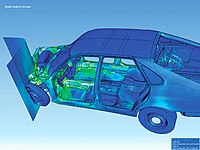
Photo from wikipedia
Abstract The spectral stochastic FEM with local basis functions in the stochastic domain (SL-FEM) is one of the most flexible and accurate stochastic methods, however, also the most computationally expensive.… Click to show full abstract
Abstract The spectral stochastic FEM with local basis functions in the stochastic domain (SL-FEM) is one of the most flexible and accurate stochastic methods, however, also the most computationally expensive. These expenses are traditionally associated with the extra large tangent stiffness matrix and a huge number of elements which need to be re-integrated in every iteration. In this work we incorporate the proper orthogonal decomposition (POD) into the SL-FEM, thus performing a drastic reduction of the stiffness matrix. In order to reduce the integration costs by hyperreduction, a novel element-based modification of the discrete empirical interpolation, the so-called element-based empirical approximation method (EDEAM), is developed and combined with the POD. Particular advantages of the SL-FEM for order reduction and hyperreduction compared to other stochastic techniques are discussed. The new reduced-order SL-FEM is applied to the computational homogenization of materials with random geometry of the microstructure, i.e. to a general class of problems exhibiting strongly nonlinear, non-smooth and sometimes discontinuous dependency of the solution on some random parameters. The reduced-order SL-FEM demonstrates a high accuracy and a high solution speed, whereby the solution time for the reduced-order SL-FEM is comparable to the solution time of only one single Monte-Carlo sample.
Journal Title: Computer Methods in Applied Mechanics and Engineering
Year Published: 2020
Link to full text (if available)
Share on Social Media: Sign Up to like & get
recommendations!